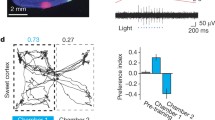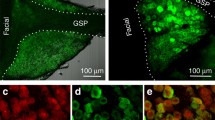Abstract
The mechanism of switching activity patterns in a central pattern generator is fundamental to the generation of diverse motor behaviors. Based on what is known about a brainstem substrate mediating the oral components of ingestion and rejection, we use computational techniques to construct a hypothetical multifunctional network that switches between the motor outputs of ingestion (licking) and rejection (gaping). The network was constructed using single-compartment conductance-based models for individual neurons based on Hodgkin-Huxley formalism. Using a fast-slow reduction and geometric analysis we describe a mechanism for pattern switching between licks and gapes. The model supports the hypothesis that a single configuration of network connections can produce both activity patterns. It further predicts that prolonged inhibition of some network neurons could lead to a switch in network activity from licks to gapes.











Similar content being viewed by others
References
Amri M, Car A, Roman C (1990). Axonal branching of medullary swallowing neurons projecting on the trigeminal and hypoglossal motor nuclei: demonstration by electrophysiological and fluorescent double labeling techniques. Exp. Brain Res. 81: 384–390.
Buchanan JT (1982a). Activities of identified interneurons, motoneurons, and muscle fibers during fictive swimming in the lamprey and effects of reticulospinal and dorsal cell stimulation. J. Neurophysiol. 47: 948–960.
Buchanan JT (1982b). Identification of interneurons with contralateral, caudal axons in the lamprey spinal cord: synaptic interactions and morphology. J. Neurophysiol. 47: 961–975.
Chandler SH, Tal M (1986) The effects of brain stem transections on the neuronal networks responsible for rhythmical jaw muscle activity in the guinea pig. J. Neurosci. 6: 1831–1842.
Chen Z, Travers JB (2003) Inactivation of amino acid receptors in medullary reticular formation modulates and suppresses ingestion and rejection responses in the awake rat. Am. J. Physiol. Regul. Integr. Comp. Physiol. 285: R68–R83.
Chen Z, Travers SP, Travers JB (2001) Muscimol infusions in the brain stem reticular formation reversibly block ingestion in the awake rat. Am. J. Physiol. Regul. Integr. Comp. Physiol. 280: R1085–R1094.
DiNardo LA, Travers JB (1994) Hypoglossal neural activity during ingestion and rejection in the awake rat. J. Neurophysiol. 72: 1181–1191.
DiNardo LA, Travers JB (1997) Distribution of fos-like immunoreactivity in the medullary reticular formation of the rat after gustatory elicited ingestion and rejection behaviors. J. Neurosci. 17: 3826–3839.
Donato R, Nistri A (2000) Relative contribution by GABA or glycine to Cl--mediated synaptic transmission on rat hypoglossal motoneurons in vitro. J. Neurophysiol. 84: 2715–2724.
Ermentrout GB (2002) Simulating, analyzing and animating dynamical systems, 2nd edn. SIAM Press, Philadelphia.
Evans CG, Romero A, Cropper EC (2005) Inhibition of afferent transmission in the feeding circuitry of aplysia: persistence can be as important as size. J. Neurophysiol. 93(5): 2940–2949.
Fuller D, Mateika JH, Fregosi RF (1998) Co-activation of tongue protrudor and retractor muscles during chemoreceptor stimulation in the rat. J. Physiol. 507(Pt 1): 265–276.
Grill HJ, Kaplan JM (2002) The neuroanatomical axis for control of energy balance. Front Neuroendocrinol. 23: 2–40.
Grill HJ, Norgren R (1978) Chronically decerebrate rats demonstrate satiation but not bait shyness. Science 201: 267–269.
Hodgkin AL, Huxley AF (1952) A quantitative description of membrane current and its application to conduction and excitation in nerve. J. Physiol. 117: 500–544.
Inoue T, Chandler SH, Goldberg LJ (1994) Neuropharmacological mechanisms underlying rhythmical discharge in trigeminal interneurons during fictive mastication. J. Neurophysiol. 71: 2061–2073.
Kupfermann I (1974) Dissociation of the appetitive and consummatory phases of feeding behavior in aplysia: a lesion study. Behav. Biol. 10: 89–97.
Li YQ, Takada M, Mizuno N (1993a) Premotor neurons projecting simultaneously to two orofacial motor nuclei by sending their branched axons. a study with a fluorescent retrograde double-labeling technique in the rat. Neurosci. Lett. 152: 29–32.
Li YQ, Takada M, Mizuno N (1993b) The sites of origin of serotenergic afferent fibers in the trigeminal motor, facial and hypoglossal nuclei in the rat. Neurosci. Res. 17: 307–313.
Li YQ, Takada M, Kaneko T, Mizuno N (1996) GABAergic and glycinergic neurons projecting to the trigeminal motor nucleus: a double labeling study in the rat. J. Comp. Neurol. 373: 498–510.
Li YQ, Takada M, Kaneko T, Mizuno N (1997) Distribution of GABAergic and glycinergic premotor neurons projecting to the facial and hypoglossal nuclei in the rat. J. Comp. Neurol. 378: 283–294.
Lund JP, Sasamoto K, Murakami T, Olsson KA (1984) Analysis of rhythmical jaw movements produced by electrical stimulation of motor-sensory cortex of rabbits. J. Neurophysiol. 52: 1014–1029.
Lund JP, Kolta A, Westberg KG, Scott G (1998) Brainstem mechanisms underlying feeding behaviors. Curr. Opin. Neurobiol. 8: 718–724.
Marder E, Pearson KG (1998) Editorial overview: motor control from molecules to bedside. Curr. Opin. Neurobiol. 8: 693–696.
Matsushima T, Tegner J, Hill RH, Grillner S (1993) GABA\(_B\) receptor activation causes a depression of low- and high-voltage-activated Ca2+ currents, postinhibitory rebound, and postspike afterhyperpolarization in lamprey neurons. J. Neurophysiol. 70: 2606–2619.
Nakamura Y, Katakura N (1995) Generation of masticatory rhythm in the brainstem. Neurosci. Res. 23: 1–19.
O'Brien JA, Berger AJ (1999) Cotransmission of GABA and glycine to brain stem motoneurons. J. Neurophysiol. 82: 1638–1641.
Popratiloff AS, Streppel M, Gruart A, Guntinas-Lichius O, Angelov DN, Stennert E, Delgado-Garcia JM, Neiss WF (2001) Hypoglossal and reticular interneurons involved in oro-facial coordination in the rat. J. Comp. Neurol. 433: 364–379.
Rinzel J (1985) Bursting oscillations in an excitable membrane model. Ordinary and Partial Differential Equations. Springer, New York.
Rinzel J, Ermentrout GB (1998) Analysis of neural excitability and oscillations. In: C Koch and I Segev, eds. Methods in Neuronal Modeling: From Ions to Networks, 2nd edn.MIT Press, Cambridge, MA.
Rubin JE, Terman D (2002) Geometric Singular Perturbation Analysis of Neuronal Dynamics. 2nd edn. Fiedler B, Elsevier Science B.V.
Russier M, Kopysova IL, Ankri N, Ferrand N, Debanne D (2002) GABA and glycine co-release optimizes functional inhibition in rat brainstem motoneurons in vitro. J. Physiol. 541: 123–137.
Scott G, Westberg KG, Kolta A, Vrentzos N, Lund JP (1998) Organization of the brainstem pattern generator of mastication. J. Dent. Res. 77–115.
Steiner JE (1973) The gustofacial response: observation on normal and anencephalic newborn infants. Symp. Oral Sens. Percept. 4: 254–278.
Tegner J, Matsushima T, el Manira A, Grillner S (1993) The spinal GABA system modulates burst frequency and intersegmental coordination in the lamprey: differential effects of GABA\(_A\) and GABA\(_B\) receptors. J. Neurophysiol. 69: 647–657.
Thexton AJ (1992) Mastication and swallowing: an overview. Br. Dent. J. 173: 197–206.
Travers JB, Norgren R (1983) Afferent projections to the oral motor nuclei in the rat. J. Comp. Neurol. 220: 280–298.
Travers JB, and Norgren R (1986) Electromyographic analysis of the ingestion and rejection of sapid stimuli in the rat. Behav. Neurosci. 100: 544–555.
Travers JB, Rinaman L (2002) Identification of lingual motor control circuits using two strains of pseudorabies virus. Neuroscience 115: 1139–1151.
Travers JB, DiNardo LA, Karimnamazi H (1997) Motor and premotor mechanisms of licking. Neurosci. Biobehav. Rev. 21: 631–647.
Travers JB, DiNardo LA, Karimnamazi H (2000) Medullary reticular formation activity during ingestion and rejection in the awake rat. Exp. Brain Res. 130: 78–92.
Travers SP (2002) Quinine and citric acid elicit distinctive fos-like immunoreactivity in the rat nucleus of the solitary tract. Am. J. Physiol. Regul. Integr. Comp. Physiol. 282: R1798–R1810.
Travers SP, Hu H (2000) Extranuclear projections of rnst neurons expressing gustatory-elicited fos. J. Comp. Neurol. 427: 124–138.
Turman J Jr, Chandler SH (1994) Immunohistochemical evidence for GABA and glycine-containing trigeminal premotoneurons in the guinea pig. Synapse 18: 7–20.
Travers JB, Yoo J, Chandran R, Herman K, Travers SP (2005) Neurotransmitter phenotypes of intermediate zone reticular formation projections to the motor trigeminal and hypoglossal nuclei in the rat. J. Comp. Neurol. 488: 28–47.
Acknowledgments
This work was partially funded by NIH grant DC00417 (JBT) and NSF grant DMS0514356 (DT). This work was also partially funded by NSF grant under agreement number 0112050. We thank Praveen Shankar for helpful comments and technical assistance
Author information
Authors and Affiliations
Corresponding author
Additional information
Action Editor: Frances K. Skinner
Rights and permissions
About this article
Cite this article
Venugopal, S., Travers, J.B. & Terman, D.H. A computational model for motor pattern switching between taste-induced ingestion and rejection oromotor behaviors. J Comput Neurosci 22, 223–238 (2007). https://doi.org/10.1007/s10827-006-0009-3
Received:
Revised:
Accepted:
Published:
Issue Date:
DOI: https://doi.org/10.1007/s10827-006-0009-3




